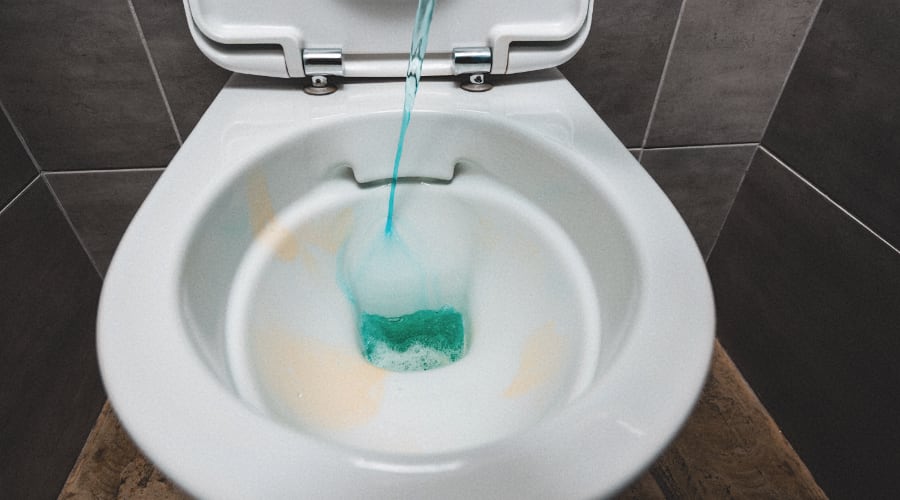A clogged toilet is something that no one really wants to think about.
Not only is it a huge inconvenience, but the process of unclogging the toilet can be downright disgusting. So, the important question is; how to unclog toilet when nothing works?
After doing a bit of research on the matter, we’ve come up with several solutions on unclogging toilets when nothing seems to get the job done.
How to Unclog a Toilet When Nothing Works
Sometimes a stubborn toilet clog can take you by surprise. When it does, it’s best to know which methods work best to help dissolve it.
Some of the methods mentioned below will be able to clear your blocked toilet within a few minutes, while others may take a little more elbow grease.
All in all, rest assured that this list is the “best of the best” when it comes to clogged-toilet solutions.
1. Use a Plunger
There are certain tools that work perfectly for unclogging the toilet, such as a plunger.
If you need a heavier plunger, you can either purchase one with a flange or get one with a heavy-duty grip.
Before using the plunger, be sure that you wear rubber gloves to protect yourself from any splashing.
Once ready, insert the rubber part of the plunger into the toilet bowl while holding the handle. Then, push it down slowly toward the bowl. Insert it and pull it up quickly a few times so that you create a tight vacuum.
This will suck out the clog, and the water and waste will be pushed down the toilet drain. If this doesn’t work, move on to another method.
2. Use a Mixture of Baking Soda and Vinegar
If a plunger doesn’t work, consider using a combo of white vinegar and baking soda — this is also a suitable alternative. These items are likely in your pantry, but if not, you can easily get them from the store.
To use this method, start by mixing 2 or 3 cups of warm water and half a cup or so of baking soda.
Make sure that the baking soda is thoroughly dissolved before pouring it into the toilet bowl. Wait about 5 to 10 minutes, and then pour about two cups of vinegar into the toilet.
The chemical reaction of the two should work to quickly break up the clog. If not, consider another option.
3. Use Boiling Water and Dishwashing Detergent
You can also try soap and water if the plunger fails. For this method, boil one or two gallons of water on the stove and let cool a little before using it. While you’re waiting, add about a quarter cup of dish soap to the toilet bowl.
Then, slowly fill the toilet bowl with the warm water and wait for a few minutes before flushing it. This combination should loosen the clog, making it easier to remove and flush.
4. Use a Plumbing Snake (aka a “Toilet Auger”)
If you don’t have a plumbing snake (otherwise known as a “toilet snake”) in your home, you may want to consider investing in one.
With this tool’s flexibility, you can easily reach down to the very bottom of the drain. It’s a good option for solid objects, plus your porcelain is protected from scratches and damage with the snake’s rubber coating.
Before starting, don a pair of gloves so that you don’t get any waste on your hands. Begin by placing the bottom end of the snake tool inside the toilet and gently pushing it down until you feel a bit of resistance.
Next, push and turn the snake’s handle clockwise to manually force the toilet obstruction down the drain — you should be able to tell when the snake moves freely without resistance.
Afterward, flush the toilet to make sure that it’s clear. If it still doesn’t flow as much as it should, try the process one more time as there may still be pieces of debris in the drain.
If this still fails after two attempts, try another option.
5. Use a Wire Coat Hanger
Did you know that you can also use a wire coat hanger to unclog a toilet? Well, you can!
Start by grabbing a wire hanger from the closet and straightening it out. Cover one end of it with a cloth to prevent the wire from scratching and damaging the toilet’s porcelain — duct tape can be used to secure the fabric.
The method is ideal when the obstruction is only a couple of inches into the drain. Once you have your rubber gloves on, place the covered end of the semi flexible wire hanger into the bowl.
Push the wire hanger into the drain, twisting as you go. By doing this, the wire is allowed to move through the drain and clear out anything clogging it. If you start to feel resistance, keep pushing past it until the toilet water drains.

6. Use an Enzyme Product
A toilet drain can also be unclogged using enzyme waste removal tools — the best natural product to liquefy and disintegrate waste material and unclog your toilet.
Most grocery and home improvement stores will carry this product.
Septic systems use enzymes to maintain a proper level of waste degradation. In other words, they keep things in the toilet flowing freely. This product won’t remove toilet bowl clogs caused by toys or other solid objects, but it’ll work for biodegradable and organic waste.
Start by pouring the required amount of product into the bowl as instructed by the directions on the label. After that, wait a couple of minutes — anywhere from 10 to 30 — for the enzymes to kick in.
If it helps, set a timer. Then, flush the toilet and check to see if the water flows properly.
7. Suck Out the Clog
With this method, you’ll suck out the clog using a wet/dry vacuum. These vacuums can be purchased for about $80 at your local home improvement store.
If you want the best suction, it’s best to go with a heavy-duty model. And be sure to don a pair of rubber gloves before using the vacuum.
To use this method, start by turning on the “wet” switch on the vacuum and then powering it on to suck all of the water out of the toilet.
Once the toilet is emptied, place the end of the vacuum hose inside the drain and gently push it down as far as it’ll go. To create a bit of suction, wrap the flexible hose in an old towel or rag.
Then, start the vacuum to remove the clog. Power the vacuum for about 1 minute and then try to flush the toilet.
If this method does not work, consider using a professional strength drain cleaner.
8. Use Chemical Drain Cleaner
Try using a drain cleaner if your toilet is still clogged. You can easily find this product at your local grocery store or any home improvement store.
If your toilet is clogged with organic waste, this cleaner is made for dissolving it and liquid waste so that it’ll flush down the drain.
Take note that the toxic substances present in these cleaners can negatively impact your health, your pets, and your drain pipes. So to say, if the aforementioned methods don’t work, turn to this reliable method as a last option.
In addition, you should avoid using a cleaning tool that is not designed for toilets as this can lead to damage — if you want to buy a drain cleaner, choose one designed for this purpose.
9. Contact a Plumber
You may need to call a licensed and professional plumber if all of the tips above fail to solve your clogged toilet issue. The problem might require the removal of the entire toilet in some cases.
Keep in mind that you simply may not possess the right tools for the task, and contacting a plumber can save you from spinning your wheels.
Will a Toilet Unclog Itself?
It can, especially if the clog is from toilet paper — it’s designed to break down and dissolve when it comes into contact with water. However, if there is not enough liquid to dissolve it, it will likely remain solid and clumpy.
This can often be an issue in low-flow or low-water toilets. Always check the label on your toilet paper to make sure it’s suitable for all types of septic systems.
A clogged toilet can typically be left unattended for up to five hours before it’ll start to unclog itself, as long as the clog is from water-soluble and biodegradable waste. If it’s not, the clog simply won’t go anywhere until it’s removed manually.
It’s likely the waste isn’t biodegradable if the clog doesn’t clear within 48 hours. This means that you should check the drain pipe for foreign objects asap, as this could easily affect other pipes in your house.
4 Ways to Prevent the Toilet From Clogging
If your toilet gets clogged often, chances are that it’s caused by the way you use it. There are some habits that can cause regular clogs — let’s look at a few ways to prevent them.
Not Flushing the Toilet Frequently Enough
One of the quickest ways to clog your toilet is to fill it with too much toilet paper before flushing it.
Even if the toilet paper is 1-ply, this can cause clogging rather quickly. Don’t let the toilet paper pile up in your toilet. Instead, flush it after every use.
Not Using a Flush Cleaner
Toilet flush cleaners didn’t become a thing until about 30 years ago. However, since then, they have become a mainstay in homes across the world.
These small cleaners help to break down biodegradable objects to keep them from building up and clogging the drain inside the toilet. They are activated each time you flush the toilet, and can keep your toilet smelling fresh 24/7.
Not Cleaning the Toilet Regularly
This is especially important if you have a large family. Cleaning your toilet regularly helps to remove any waste and debris before it has a chance to become stuck inside of the toilet drain. This ultimately prevents clogs from forming before they even have a chance to.
There are tons of commercial toilet cleaners that you can use to keep your toilet looking brand new. You can also use all-natural cleaners, including a combination of vinegar and baking soda, or even lemon juice, to remove hard water stains from your toilet.
Flushing Things Other Than Toilet Paper Down the Toilet
Sometimes clogs are caused by people flushing things that don’t necessarily go down toilets. Here is a list of common household items that have no place in your toilet:
- Coffee grounds
- Diapers
- Kitty litter
- Floss
- Feminine hygiene products
- Grease
- Cotton balls
- Tissues
- Baby wipes
- Paper towels
- Medications
Remember, if what you’re flushing isn’t biodegradable, you may find yourself with a toilet clog requiring a great amount of effort — or even a plumber — to remove.
Be sure to only flush toilet paper down your toilet.
Final Thoughts
Having a clogged toilet is no fun. But, luckily, there are several different techniques that you can use to remove the clog and prevent more toilet clogs in the future.
If one method doesn’t work, you should always try a couple of more before contacting a plumber about the issue.
However, more often than not, you’ll find that a plunger will quickly get rid of the clog for you. If not, an enzyme solution or drain cleaner may be your best bet.
